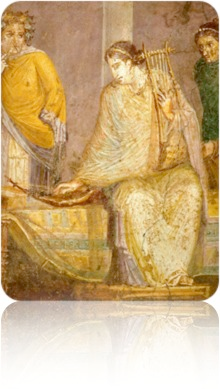Lesson 2: Ancient Music
Lesson 2: Ancient Music

Lesson 2: Ancient Music
Ancient Music
As time passed, people continued to improvise and create new forms of music and musical instruments. The evolution of musical instruments appears to have been a slow but steady one, from the early flutes and human-created sounds to early trumpet forms and harps. What is considered ancient music is music produced by early literate societies. Humans developed written language about 4000 BCE, so ancient music belongs to those societies that lived at or after this time. Like written languages, music did not develop at the same rate or in the same way in every place. Since societies were often relatively isolated from each other, people did not learn about new musical instruments or new pitches from other cultures for quite some time. Instead, the music in one place often evolved slowly, with the gradual inclusion of information from other musical societies as that information was passed along during trade or migration.
Roman fresco from Pompeii
One of the changes as prehistoric music evolved to ancient music was that the music became more standardized. Rather than random sounds or tones, ancient music often featured deliberate patterns as well as the repetition of these patterns within a piece of music. Although music didn't appear to be written down until later and we're not sure what much of the music sounded like, the music is described as more standardized. The major ancient societies developed their own types of music and different instruments. Let's take a look at some of these societies and the music produced by their members.
Egypt
Ancient Egypt is known for its advanced society and technologies, including the pyramids and hieroglyphics. They also made a number of advances and changes to the music that had come before them. Ancient Egyptians, like many other societies at that time, believed that music was a gift to humans from the gods. Music was often played in the temples as part of religious life. Archaeologists have found murals and other artwork depicting musicians and individuals dancing to music.
Scholars are not sure what the music sounded like in early ancient Egyptian society. From the evidence uncovered by archaeologists and other scholars, it is believed that the early Egyptian music used a five-tone scale. They also appear to have used both male and female voices in their works. The Egyptians also developed or adopted a number of different types of instruments. Lutes and string harps were played as early as 4000 BCE. Other instruments developed by the Egyptians included lyres, clarinets, tambourines, trumpets, and guitars. Some of these instruments, particularly harps, were often adorned with precious materials such as gold, silver, and lapis lazuli.
Mesopotamia
In Mesopotamia (current-day Iraq and surrounding areas), archaeologists and other scholars found evidence of music scales and different musical instruments. Several excavations in different parts of Mesopotamia lend credence to the idea that the ancient world had a form of music notation or the ability to write a song or musical piece down so that it could be played again in the same way. A cuneiform tablet discovered in Nippur dating to about 2000 BCE seems to give instructions for performing particular pieces of music. Although the notation on these tablets is fragmentary and the interpretation of it is still controversial, it appears to be one of the first examples of musical notation. At Ugarit (in present-day Syria), the Hurrian song was found in the 1950s. The Hurrian song refers to a set of fragmentary relics as well as a nearly complete example of notated music from around 1400 BCE. The almost complete song or hymn is written in cuneiform writing on clay tablets. At least one of the tablets is noted as a song, and the musical notation appears to have been written for the nine-stringed lyre.
Excavation of numerous sites also indicates that music played a large role in the lives of Mesopotamians. Art from this time period features people playing lyres, for example, and music was played during important life events, such as marriages and royal family births. The instruments used to create music included lyres (stringed instruments), harps, reed pipes, lutes (stringed instruments with a neck), and drums. The evidence suggests that music was central to religion and religious rites for many Mesopotamian groups. By 1800 BCE, the Babylonians were using psalms and hymns in their religious services. The music was often two different voices alternating in their chants.